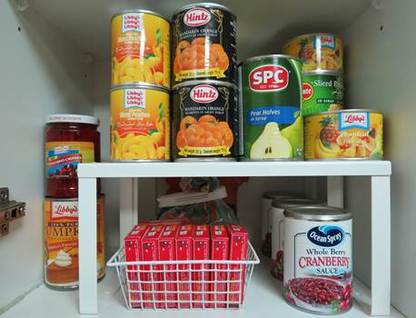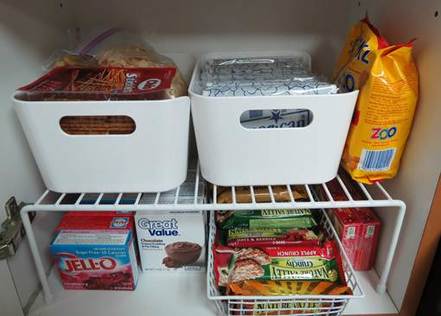|
|
How to Organize Kitchen Cabinets |
|
Once every nook and cranny of your cupboards has been emptied and the contents sorted and purged, it's time to organize your kitchen cabinets. If you followed the advice on my Declutter Your Kitchen Cabinets page and sorted like items together based on your plan for kitchen work zones, then you’re half way there! If you haven’t already done so, decide which cabinets will be dedicated to housing the equipment and/or food for each work zone.
|
|
Tip: Label It! |
|
When setting up kitchen cabinets, I recommend using sticky notes to label each cabinet's contents. Things are likely to be arranged a little (or a lot) differently than they were before you emptied your cupboards. This will help you and your family to get used to the new layout.
In my home this step is crucial because my husband is an imprinter. If I change my mind and relocate something one week after we have moved into a new home, he will spend the next two years looking for it in the wrong place – because that’s where it was to begin with. Labels help to solidify the new location in his (and everyone’s) mind, and they’re easy to peel off once everyone has gotten used to the new arrangement.
In my home this step is crucial because my husband is an imprinter. If I change my mind and relocate something one week after we have moved into a new home, he will spend the next two years looking for it in the wrong place – because that’s where it was to begin with. Labels help to solidify the new location in his (and everyone’s) mind, and they’re easy to peel off once everyone has gotten used to the new arrangement.
Focus on Function |
|
In order to truly organize your kitchen cabinets, you will need to put some thought into how you arrange the items within each cupboard. Your goal should be to make things as easy to access as possible, particularly those items you use most frequently.
Keep these factors in mind when deciding which items will go where as you organize kitchen cabinets:
Since that is all a little confusing, here is a diagram to demonstrate how to organize kitchen cabinets.
Keep these factors in mind when deciding which items will go where as you organize kitchen cabinets:
- In general, heavier items should be located in lower cabinets and lighter items in upper cabinets.
- Within each cabinet, place the most frequently used items at the front and the items used less frequently at the back.
- Items which are used daily should be placed on the bottom shelves of upper cabinets where they are most easy to access.
- Some daily use items can be placed on the counter top for easy access, but these should be limited to prevent clutter and preserve work space. Likely candidates for counter top privileges include regularly used cooking utensils stored in a decorative crock, the toaster, the coffee maker, or some other small appliance which receives daily use.
- Items which are used one or more times a week should be placed at the front of lower cabinets where they are relatively easy to reach.
- Items which are used infrequently go on either the bottom shelf of the lower cabinets or the top shelf of the upper cabinets.
- Items which are used only for special occasions, such as roasting pans or holiday platters, should be relegated to the most difficult to access locations within your kitchen such as the cupboard above the refrigerator. Another option is to keep these items in a storage area outside the kitchen such as the basement.
Since that is all a little confusing, here is a diagram to demonstrate how to organize kitchen cabinets.
Kitchen Cabinet Space Saving Tips |
|
Utilize these basic space saving tips to better organize your kitchen cabinets.
|
|
|
Organized...Enough |
|
Some of us think that everything has to be absolutely organized all the time. I'm here to tell you that it's OK to settle for less than perfect sometimes. An example of this is the lid drawer in my kitchen. It's organized...enough. All the lids are in one place - that's order. But the lids are not arranged in neat stacks. They are just tossed in loosely. It's good enough for me, and it's easy for everyone else to maintain. It's liberating, really.
From the time my oldest child was a crawler until my youngest child was about three I always made sure that the lid drawer was the lowest drawer in the kitchen. I also made sure the baby knew where it was, and I invited him (or her) to disassemble it at his (or her) pleasure. It was a great way to keep my little one entertained while I was cooking or cleaning in the kitchen, and it was easy to pick up when we were both done - I just tossed everything back in the drawer. It was organized...enough.
From the time my oldest child was a crawler until my youngest child was about three I always made sure that the lid drawer was the lowest drawer in the kitchen. I also made sure the baby knew where it was, and I invited him (or her) to disassemble it at his (or her) pleasure. It was a great way to keep my little one entertained while I was cooking or cleaning in the kitchen, and it was easy to pick up when we were both done - I just tossed everything back in the drawer. It was organized...enough.
Tips for Storing Food |
|
Don't overlook the organization of food as you organize kitchen cabinets. You should put as much thought into the arrangement of food within your cupboards as you do the arrangement of the tools used to prepare the food. A well-organized food cupboard can save you time, frustration, and money. By arranging items in a way that makes them easy to identify and locate you can quickly find what you are looking for and avoid purchasing items you already have (but can’t find).
Utilize the following strategies for storing food efficiently as you organize kitchen cabinets.
- Store cans with labels facing forward so that everything is easy to identify at a glance.
- Stack cans of the same product on top of each other in order to better utilize space.
- Create rows of similar items, such as beans or soups, three or four deep within the cabinet. Try to avoid putting unrelated items in the same row – i.e. don’t stack the soup behind the beans if you can avoid it.
- Oldest items should be stored at the front of the cabinet and newer items at the back. This will ensure that everything gets used before it expires and nothing goes to waste.
- Store bagged items (pasta, popcorn, rice) in baskets or bins to better contain them. Another option is to remove these items from their original packaging and store them in airtight containers. This is an excellent method if you know you’re the kind of person who will diligently transfer the product from its bag to the container when you buy more. If not, you will just end up with a lot of mostly empty containers taking up valuable space in your cupboards.
Enjoy the Fruits of Your Labors |
|
Daunting as the task may seem, you won't regret the time you take to organize kitchen cabinets. There is something really satisfying about opening a cupboard door and finding shelves lined with tidy rows of logically sorted cans or neat stacks of dishes arranged according to size. Better still than the emotional fulfillment this feat will bring is the time and money, not to mention the frustration, that you will save by having an organized kitchen.
Proudly powered by Weebly




